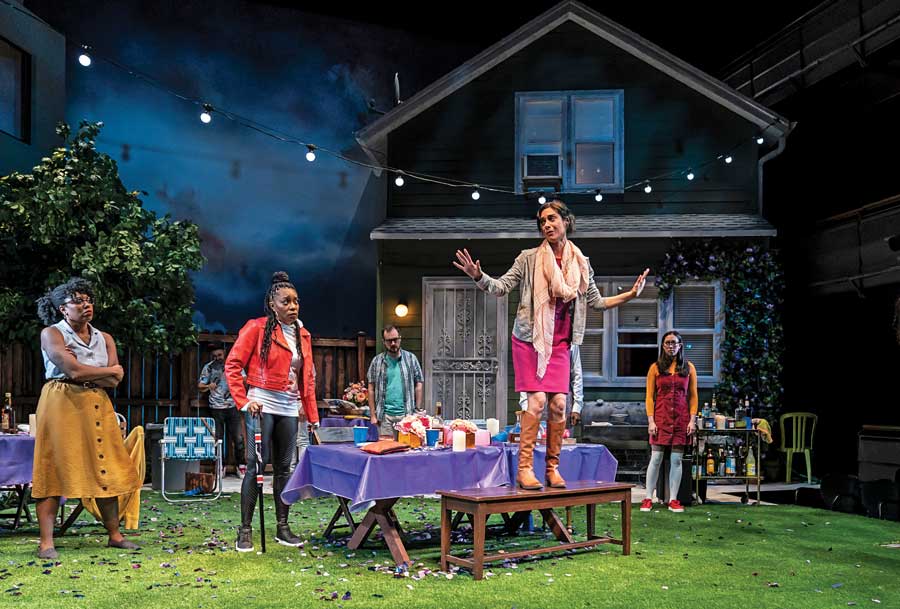This story is part of a package of stories on Chicago theatre. For more, go here.
A dramaturgy conference in Chicago this past June, titled “Crossing Borders, Pt. 2: Action in a Time of Division,” addressed a history of segregation and Otherness in the city and beyond. The goal was to put participants in a solution-oriented mindset. As the convening’s local coordinator, I can speak to our good intentions and ethic of care. But I recall one moment that challenged us to consider how to hold ourselves accountable.
In one session, a panelist described themself as a “theatrical terrorist,” i.e., someone outside institutions pushing in, applying pressure. The house roared with laughter at the word “terrorist,” but I went from being the session’s moderator, sharing space and bandwidth on a mic, to a brown girl getting chased off the “L” train—as a person of Middle Eastern descent, that word hit me hard. I paused us for two beats and acknowledged the legacy of that word, and how it’s not to be taken lightly. Another breath and we continued.
I’m not arguing that this is enough, or even revolutionary. But something shifted in that hold-please moment.
Our field could use more moments like that. For no matter how much care and intention go into providing access for all people and their bodies, in the U.S. and the West we have a history of colonialism and systemic racism to reckon with. This reckoning manifests in various ways, and Chicago, for all of its demographic diversity, isn’t immune to the racism and (not so blissful) ignorance that plagues American theatres more generally. Many artists see the theatrical experience as a sacred one, comparing it to a church-like experience promising transformation. This is quite apt for the Chicago theatrosphere, where storefront mythologies often take root in church basements. But churches have their tensions, and its congregants have their sins of omission.
Racist housing policies are the foundation upon which Chicago’s inequities are built.
When considering the roots of Chicago’s racism, it’s important to remember how much of it was codified in law. Black people and people of color were redlined out of homeownership, gerrymandered out of votes, and evicted in the face of bulldozers for an expressway. This history impacts where and how theatre is made in Chicago. It impacts who can get to the theatre and who can afford it. Rejection or ignorance of these roots even breeds a lack of cultural competency in criticism, furthering erasure.
What has literally paved the way for the inequities we see today in the arts is a larger system designed to keep people of color out of power and at the margins. We can trace it to the manipulative treaties that forced the Potawatomi off their land in the early to mid-19th century. Or to the Great Migration from 1916 to 1970, when real estate power grappled with the arrival of 500,000 Black folks and the creation of arbitrary covenants to keep them constrained to the South and West sides of Chicago. This was compounded by the policy of redlining, which under the Federal Housing Administration from 1934 through 1968 determined which neighborhoods were fit for mortgages based on racial and ethnic composition. Written into deeds was the stipulation that houses could neither be sold nor rented to Black people.
But with the Great Depression, white buyers were few and far between. In a famous Chicago case, one that became the roots of Lorraine Hansberry’s A Raisin in the Sun, her father, Carl Hansberry, was able to purchase a house in the then white neighborhood of West Woodlawn on the South Side.
“The Hansberrys faced racial violence because they lived there,” says Natalie Y. Moore, a journalist and South Side native. “Mrs. Hansberry walked around the house with a shotgun. Their daughter Lorraine was injured by something thrown into the house.” This ended at the the Supreme Court with Hansberry v. Lee in 1940, which rules that the Hansberrys “should be allowed to live there, but not because of equal protection of the law but because not enough white homeowners had signed the petition saying that Blacks could be kept out.”
Racist housing policies are the foundation upon which Chicago’s inequities are built. More recently, the Dan Ryan expressway, opened in 1961, cut through the heart of the South Side’s vibrant neighborhoods. Public housing was built only in Black neighborhoods. To this day the Chicago Transit Authority Red Line train only goes to 95th St., though the city goes to 130th St. Black and brown neighborhoods on the South and West sides continue to face disinvestment.
A 2016 leadership transition at the Field Foundation of Illinois—an independent foundation that significantly supported local arts for nearly 80 years—led to rigorous research and mapping of its own past funding patterns. This project unveiled some troubling patterns. As arts program officer Tempestt Hazel puts it, this “fact-finding mission” was designed to provide a “new way of being extremely focused and racially explicit about grantmaking.” The result was a series of “heat maps” illuminating much of the Chicago racial divide in terms of quality-of-life indicators, such as school closings, commute times, health insurance, and access to the arts.
The maps showed that the foundation’s previous grantees were almost exclusively on the North Side, and ignored organizations serving communities on the South or West Sides. In essence, their funding went to predominantly white and wealthier organizations. Armed with this data, the foundation demonstrated what not only they but all responsible funders must acknowledge when supporting Chicago nonprofits: a legacy of disinvestment that will only continue without a more strategic and explicit funding model focused on racial equity.
This history and its impact lie beneath us, including our theatres. It is easy to mythologize some institutions as totems of Chicago theatre and fail to acknowledge how privileges of whiteness, education, and city resources helped make it possible. Historic institutions including Goodman, Steppenwolf, and Lookingglass are a part of this North Side-based and largely white legacy. In his book A Theater of Our Own, critic Richard Christiansen laments, “The problem with writing about theatre in Chicago is that it resists comprehensiveness.” The same could be said about its racism.
Although institutions uphold representation, a POC artist’s ability to self-represent remains novel.
At these predominantly white-built institutions on the North Side, including many in the Loop and Off-Loop theatre districts, artists and audiences of color were not initially in the picture. Prominent Chicago playwright Ike Holter remarks, “Ensemble hangs over the theatre like a mythology. It means people working together, supposedly for a greater good.” But the downside of such tight-knittedness, he adds, is that “these ensembles that have been around for decades… are full of these white people from the ’80s and ’90s.” This has meant not only that stories on Chicago stages for too long failed to reflect the diversity of the city, but also that for non-North Side artists and audiences the commute to these stages could be an all-consuming task, a powerful barrier to entry in itself.

Chicago is geographically large, and transportation is not equally accessible across the city. “We have this idea that the Loop in Chicago is central, and it’s not,” says Coya Paz Brownrigg, artistic director of Free Street Theater. “The Loop is east—it’s as far east as you can get in the city and it’s pretty far north. It’s not the midway point of the city at all.” For many of Chicago’s people of color and lower-income residents, a single trip to a North Side venue might require “two trains and a bus” to get to the theatre.
In response to this lack of access, POCs founded their own theatres. The Civil Rights Movement of the 1960s provided an initial catalyst for theatres founded by artists aiming to make theatre in and with historically disinvested and marginalized communities. Among the earliest was Free Street Theater, founded in 1969 as a multiracial company with a mission of challenging racial and economic injustice. This meant eschewing a traditional brick-and-mortar model of performance. Under the direction of Patrick Henry, Free Street performed in public spaces for audiences who generally would not have seen theatre otherwise. Another long-running institution, the Black Ensemble Theater, founded in 1976 by Jackie Taylor, had a similar mandate to fight racism via authentic storytelling and community organizing.
Chicago, according to Paz Brownrigg, has always been a city amenable to a growing scene, and theatre artists have accordingly always made space here wherever they could. In 2000 she co-founded Teatro Luna.
“At the time [Teatro Luna] was Chicago’s first and only all-Latina theatre company,” Paz Brownrigg recalls. “It was a city that made that possible. At the same time, part of why we had to start that theatre company was because there were so few opportunities for Latina women on Chicago stages. So I think that do-it-yourself mentality can be a double edge for some people. It’s part of why you have to do-it-yourself—nobody is including you at the party. You have to start your own party.”
But these culturally specific organizations continue to be under-recognized as credible institutions by mainstream papers and granters, as they are often viewed as lower-tiered than larger, subscription-based regional theatres, as if size were congruent with quality. As Ricardo Gamboa, a South Side scholar and theatremaker, puts it, “That’s a way of perpetuating racism, because it erases you from the archive. It tries to suffocate that work and kind of bury it by trying to make it a non-option in theatre offerings by not even letting people know that it’s there.”
Here we can consider both critics and funders as kinds of cultural gatekeepers of stories and of voices, of who gets to speak and who is considered valuable and credible. Without resources or attention, POC-founded and -run theatres are unable to coalesce into something sustainable. Although institutions uphold representation, a POC artist’s ability to self-represent remains novel.
These historically white theatres will program a “diverse” season yet still hire white directors and creative teams.
It is somewhat ironic, then, that at mainstream white institutions, “diversity” has become a buzzword used in marketing materials and mission statements in hopes of attracting a “diverse” audience (i.e., more money) and grants (i.e., even more money). With this narrow interest in mind, the real work of diversifying the entire institution is not an immediate priority. These historically white theatres will program a “diverse” season yet still hire white directors and creative teams. This leaves working artists of color vulnerable as they are hired into productions ill-equipped to tell their stories.
What might break this pattern is the work happening in education departments. When looking to the roster of full-time staff and freelance teaching artists at theatres like Goodman, Steppenwolf, and TimeLine, the education departments are often made up of POCs. Interestingly enough, though, most of this effort impacts youth externally, leaving much of the theatres’ internal inequities to flourish.

Indonesian-Lebanese actor Arti Ishak, with credits at Goodman, Silk Road Rising, and Victory Gardens, questions representation onstage because it pits artists against each other in problematic ways.
“As a biracial actor and as someone who is trilingual, it is often tough for me to be recognized as an Asian American actor in this city, and I fully believe it is based on the way I look from the perspective of whiteness,” Ishak says. “I do not ‘look like’ an Asian American. I think that type of mentality affects a lot of people of color in this city. Both in the way of excluding them from jobs they may be right for, but also including them in jobs that are deeply problematic to cross-cast. It imposes this idea that some people of color could pass for anything.”
Ishak even performed a solo piece specifically on being biracial, but was still siloed into an “Arab Muslim” box by a white critic. It’s as if by advocating for color-conscious casting we’ve been flung to the other side of the spectrum, where observers only take into account our most visually dominant identity.
Indeed, the city’s critical dialogue, like the leadership of its major theatres, is still lacking voices of color. So when work by people of color in Chicago gets reviewed by white critics, implicit bias can’t help but be present. Sometimes it’s not so implicit, as in the case of the infamous Hedy Weiss review of Pass Over at Steppenwolf in the Chicago Sun-Times in 2017. Reviewing a play about two Black youths accosted by a white police officer, Weiss relied on the stereotypes of “black-on-black” crime to discount the play’s portrait of police brutality, which is not an academic or hypothetical issue for everyday Chicagoans. In response, many theatres banded together to deny Weiss complimentary press tickets, and eight months later the Sun-Times fired Weiss, a 33-year veteran at the job whose Pass Over review was hardly her first run-in with readers who found her comments bigoted. White freelancers now share the reviewing duties there, with the exception of a recent piece by Sheri Flanders, who may be their first Black critic.
A HowlRound article published merely two months before this controversy proved prescient. In it Chicago dramaturgs Regina Victor and Tanuja Jagernauth penned “The Need for Cultivating Theatre Critics of Color,” outlining a history of harmful reviews. Victor then partnered with Katherine O’Keefe and co-founded an alternative platform, Rescripted.org, for what they call “empathetic and culturally competent” criticism.
“Being able to send critics who care about the fact that that show is being produced, who feel as though the show is representing them in any way, who feel as though the show is moving a conversation about their culture forward, makes a massive difference in the product,” says Victor. “It is more specific. It is more loving. It is contextualized. It is usually placed in artistic and cultural legacy, which is something that is often lacking in mainstream coverage.” Victor also launched the Key, a mentorship program supporting young critics, of which I’m an alum.
This is not to say critics should be barred from reviewing shows outside of their experience, but rather to highlight the possibility of depth and specificity if reviewers acknowledged how different bodies move through Chicago in different ways.
Theatres cannot continue to program one or two shows as tokens toward progress
Here we should consider what the future of theatre must look like if we want it to reflect our city and our world. We must interrogate our infrastructure, disrupt the barriers to engagement, and reimagine how we make theatre. Hiring people of color throughout the entirety of an organization would be a start, since in Chicago very few multi-million-dollar theatres are run by people of color, with the exception of Victory Gardens and Black Ensemble Theater. Lowering or abolishing ticket prices shouldn’t be a radical proposition; neither should bringing theatre to Chicago’s historically disinvested communities. And making theatre with community practices already in place is a necessity.
Theatres cannot continue to program one or two shows as tokens toward progress to prove the use of diversity in their mission. Boards and staff must acknowledge what it takes to function as anti-racist institutions and live their EDI missions. People of color should be on these boards and staff, and be as rigorously involved in decision-making as their white peers. In strategizing towards equity, theatres that serve disinvested populations should be given more resources and critical attention than historically white theatres.
And, crucially, it should not just be on folks who are already marginalized to do the work. Here we have the opportunity to build the world we need on and off stage. We have the tools. Demand better and use them.
Yasmin Zacaria Mikhaiel is a Chicago- and Austin-based dramaturg, writer, and oral historian. As a fat, brown, queer femme, she makes and takes space for folks on the margins. Learn more at yasminzacaria.com.


